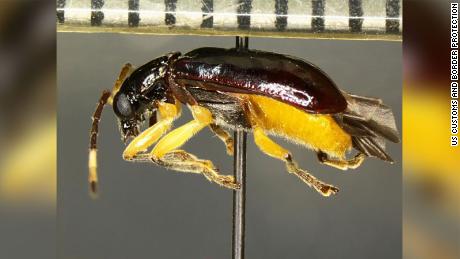Last month, a passenger traveling from Indonesia to Darwin Airport in Australia’s Northern Territory was fined $1,874 after two Egg and Beef Sausage McMuffins – with a ham croissant – were found in their luggage. (After an outbreak of foot-and-mouth disease in livestock farms in Indonesia, Australian authorities imposed strict new biosensing measures on all arrivals.)
In the past year alone, U.S. border officials have fined passengers for bringing unspecified foods in their luggage, including eggs, pork bologna and turkey ham. According to fiscal year data released by U.S. Customs and Border Protection, border officials conducted “630,150 positive inspections of travelers” in 2021 and issued thousands of fines and violations against travelers who failed to declare prohibited agricultural items.
Failure to declare food products at U.S. air, sea and land border points of entry can result in fines and penalties of up to $10,000, according to CBP.
Here’s what you need to know before bringing food products into the US.
Why are some foods not allowed?
Travelers who bring food products to the United States can unknowingly introduce foreign pests and foodborne diseases into the country, causing significant damage to agriculture and the environment. And a pest or disease outbreak can affect more than just farmers. It also means higher grocery bills and shortages of some food items for consumers.
Last year, border officials found 264 pests at US ports of entry, up from 250 the previous year. Pests intercepted last year included Saunders 1850 butterfly larvae in pineapples from Costa Rica. The larvae feed on plants and legumes, and are often considered an invasive pest in the Amazon rainforest. Introduction into the U.S. ecosystem could harm the agricultural industry, CBP said.
“We work closely with the U.S. Agriculture, Livestock and Health Inspection Service to prevent plant pests and foreign animal diseases,” a CBP spokesperson told CNN.
What kind of food products are not allowed into the country?
Most meat, poultry, dairy and egg products are banned or restricted in the US — depending on the country of origin and laws on what animal diseases are prevalent in the region.
The United States Department of Agriculture bans animal and poultry products from countries where animal diseases such as mad cow, foot and mouth, bird flu and swine fever have been reported. The USDA provides a link where travelers can check for common animal diseases in certain countries.
Sometimes, there are gray areas. Pork products from Mexico, for example, are prohibited, but small quantities for personal use – like a ham sandwich – can be allowed through land borders if the meat is well-cooked.
What kind of food products can you bring?
A long list of food items are allowed into the US, including condiments, cooking oils, bread, cookies, crackers, cakes, cereals, packaged tea and other baked and processed products. CBP provides a list of permitted items on its website.
But there’s a catch: If a traveler brings more than 50 pounds of luggage, it’s considered commercial cargo and must go through extra steps, including additional security checks. And every farm food must be declared on US customs forms, so inspectors can inspect them and make sure they don’t contain harmful foreign pests or diseases.
“The declaration must cover all items in checked baggage, carry-on baggage or vehicles,” the CBP website says.
Can you bring fruits or vegetables?
The answer is short.
All fresh and frozen fruits and vegetables are banned from entering the U.S. due to pest and disease concerns — some of which can survive in freezing temperatures, according to the U.S. Department of Agriculture. Even fruit and vegetable snacks served on planes or ships should be abandoned, said Lucero Hernandez of the federal Animal and Plant Health Inspection Service.
Travelers crossing the land border from Canada to the United States can bring some fresh fruits and vegetables with them — as long as they’re grown in Canada. But they need proof that the produce is free from soil, pests and disease and that it was grown in Canada, not just for sale there, the USDA says.
And in all cases, travelers to the U.S. should keep receipts and original packaging to prove food products are of country of origin, CBP said.
What happens if you bring prohibited items?
Travelers who declare agricultural products in their luggage will not face penalties — even if an inspector concludes the items are ineligible for entry, the USDA says. In such cases, the food is destroyed.
“A misplaced apple or snack does not always result in a significant incident,” a CBP spokesperson said, explaining that a food item is not recognized by mistake. “However, attempting to bring prohibited items may result in delays and fines for travelers.”
“Failure to declare prohibited food may result in civil penalties,” the spokesperson added.


